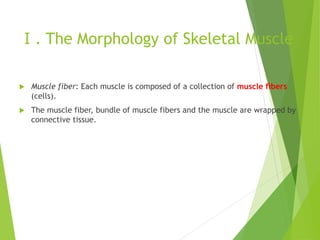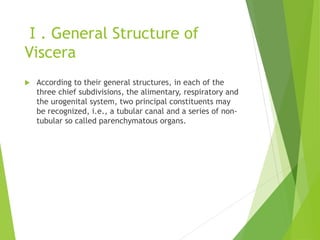myology.ppt
- 1. No. 3 1. Introduction of Myology 2. Introduction of Splanchnology
- 2. THE ROLE OF PATHOLOGY IN DIAGNOSTIC PROCESS: FROM CLINICAL REASONING TO MOLECULAR BIOLOGY. patients present with symptoms and clinical examination reveals signs which suggest a diagnosis -examination of various specimens in pathology laboratories helps to establish and confirm diagnosis, and monitor the treatment Diagnosis is the act of identifying a disease in an individual patient and is based on clinical history, physical examination and pathology investigation
- 3. Diagnosis Diagnosis involves skills and laboratory tests Special pathology techniques are used Special stains, immunohistochemistry and molecular biology techniques are routinely used
- 4. The role of pathologist: Looking at samples of tissues (biopsies) Using the range of special laboratory techniques Histology Autopsy Special stains Immunohistochemistry Electron microscopy Molecular biology techniques
- 6. Section 1 Introduction Muscle tissue constitutes almost one-half of the total body weight. Much of the body’s form is due to the numerous muscles that attach to the skeleton and underlie the skin. Other muscles are located within the walls of hollow organs and blood vessels. Muscle types: The body contains three types of muscles-- skeletal muscle, smooth muscle, cardiac muscle. Muscles can be further classified as voluntary and involuntary, on the basis of the type of control exercised over their activity.
- 7. Voluntary muscles: The contractions of voluntary muscles are normally under the conscious control of the individual. Voluntary muscles are controlled by the portion of the nervous system known as the somatic nervous system. Involuntary muscles: The contractions of involuntary muscles are generally not under the conscious control of the individual. Rather, they are governed by the portion of the nervous system known as the autonomic nervous system, as well as by hormones and by factors intrinsic to the muscles themselves.
- 8. Skeletal muscles: The muscles of locomotor apparatus are the skeletal (or striated) muscles. All of them are attached by at least one end to some part of the skeleton. The skeletal muscle is voluntary muscle because its contraction is under the voluntary control. About 40% of the body weight is shared by the skeletal muscle. Each skeletal muscle possesses a definite shape, structure, location and accessory apparatus, and is supplied by abundant blood vessels, lymphatics and nerves, so that, it can be regarded as an organ.
- 10. Smooth muscles: Smooth muscle is so named because its cells lack the striations evident in skeletal muscle cells. It is also called visceral muscle because it is found in the walls of hollow organs and tubes such as the stomach, intestines, and blood vessels. Smooth muscle is involuntary muscle, and its contractions govern the movement of materials through the organ systems of the body. Cardiac muscles: Cardiac muscle is a specialized type of muscle that forms the wall of the heart. It is involuntary, like smooth muscle, and stiated, like skeletal muscle.
- 11. Ⅰ. The Morphology of Skeletal Muscle Muscle fiber: Each muscle is composed of a collection of muscle fibers (cells). The muscle fiber, bundle of muscle fibers and the muscle are wrapped by connective tissue.
- 12. 1. Connective-tissue coverings Muscle fibers are held together by thin sheets of fibrous connective-tissue membranes called fascia. The fascia that envelops an entire muscle is called the epimysium. Fascia also penetrates muscle, separating the muscle fibers into bundles called the perimysium. We can say that the perimysium is the connective tissue that surrounds each bundle of muscle fibers. The endomysium envelops the cell membrane of each muscle fiber.
- 14. 2. Belly and tendon The fleshy part of a muscle is often called the belly. At each end of a skeletal muscle the connective tissue blends with the strong collagen bundles to form the tendon that anchors it to the bone, cartilage or articular capsule. The muscles vary extremely in their shape. It may be long, short, broad and circular band- like (sphincter). Some muscles have more than one belly or one origin. The fibers of some muscles are oblique to the long axis of the muscle. Because of their resemblance to feathers, they are called pinnate muscles.
- 17. Ⅱ. The Origin, Insertion and Action of Skeletal Muscle 1. Origin and Insertion: Most of muscles are attached either directly or by means of their tendons of aponeuroses to bones, cartilages, ligaments, fasciae or to some combination of these. Some muscles are attached to organs, such as the eyeball, and some are attached to skin or mucous membrane. When a muscle contracts and becomes short, one of its attachments usually remains fixed and the other one moves. The fixed attachment is called the origin, the movable one the insertion.
- 18. In the limbs, the more distal parts are usually mobile. Therefore the distal attachment is usually called the insertion. However, the terms origin and insertion are convenient merely for purposes of description. Sometimes the anatomical insertion remains fixed and the origin moves. Sometimes both ends remain fixed, the muscle then stabilizes a joint.
- 19. 2. Prime movers (agonists) and antagonist, synergist and fixators: During movements of the body, certain principal muscles are called into action. These muscles, called prime movers or agonists, contract actively (shorten and thicken) and produce the desired movement. A muscle that opposes the action of a prime mover is called an antagonist. The muscles which cooperate in performing an action are called synergist. Other muscles, called fixators, steady the proximal parts of a limb while movements are occurring in distal parts. A muscle may act as a prime mover, antagonist, synergist or fixator under different conditions.
- 20. Ⅲ. The Nomenclature of Muscle The names of muscles usually indicated some structural or functional feature. A name may indicate shape, e.g., rhomboid, trapezius, or gracilis. A name may refer to location, e.g., tibialis posterior. The number of heads of origin is indicated by the terms biceps, triceps, and quadriceps. The names of some muscles, such as levator scapulae and extensor digitorum, depend on their actions. Action and shape are combined in the term pronator quadratus,. The action and location are combined in the term flexor digitorum profundus.
- 21. Ⅳ. The Supplementary Structures of Muscles Ⅰ) The Fascia It is formed by connective tissue and can be divided, from where it is found, into two groups, superficial and deep.
- 22. 1. The superficial fascia It is found immediately beneath the cutis, covering almost the entire body. It is a layer of loose connective tissue containing fat in varying quantity. The superficial fascia varies in thickness in different individuals and different parts of the body. It is very dense in the scalp, in the palm of hand and the sole of foot. In the groin it is so thick that is capable of being subdivided into several laminae. Beneath the fatty layer of the superficial fascia, there is generally another layer of the same structure, comparatively devoid of adipose (fatty) tissue, in which the trunks of the subcutaneous vessels and nerves, the superficial lymph nodes, the mammary gland and certain cutaneous muscles are found.
- 24. 2. The deep fascia (proper fascia) It is a dense, inelastic fibrous membrane, forming a strong investment, which not only binds down collectively the muscles in each region, but also gives a separate sheath to each, as well as to the vessels and nerves. In the limbs, the fasciae give off septa which separate the groups of muscle and attached to the periosteum. These prolongations of fasciae are usually called the intermuscular septa. In certain situations the deep fascia affords attachment for muscles. It is thickened at the wrist and ankle to form the retinaculum that maintains its underlying tendons.
- 25. Ⅱ) The Synovial Bursa It is a connetive tissue sac with a slippery inner surface, and filled with synovial fluid. Bursa presents in the place where tendon rubs against bone, ligament, or other tendon, or where skin moves over a body prominence.
- 26. Ⅲ) The Tendinous Sheath The tendinous sheath is usually located in the hand and foot in which the tendon runs. It constitutes fibrous layer (fibrous sheath of tendon) and synovial layer (synovial sheath of tendon). Synovial sheath of tendon is a double layered synovial sheath. The outer layer is parietal layer and the inner layer is visceral layer. The mesotendom forms the continuity between the inner and outer synovial layers and carries blood vessels to the tendon. The inner layer of the synovial sheath is fused with the tendon. The fluid in the cavity of the sheath is similar to synovial fluid of the joint cavity and facilitates movement by minimizing friction.
- 27. Ⅳ) The Sesamoid Bones They are developed in those tendons exert a great amount of pressure upon the part over which they glide. They minimize the friction, change the direction of pulling force and stengthen the force of the muscle.
- 29. Chapter 1 Introduction Viscera and Splanchnology: Viscera are the organs that are mainly situated in the thoracic, abdominal and pelvic cavities and fulfill the metabolism and maintain the life of the species. They are associated with the pleura and peritoneum. According to the functions which they perform, the viscera can be arranged in the alimentary system, respiratory system, urinary system and genital system. Splanchnology means the study of viscera.
- 30. Functions: The main functions of the viscera are to fulfill the metabolism and maintain the life of the species. The alimentary system is adapted to ingest foods, to secrete enzymes that modify the sizes of food molecules, to absorb the products of this digestive action, and to eliminate the unused residues. The respiratory system is to carry out the gas exchanges- supply of oxygen for the living cells and remove of carbon dioxide resulting from cell metabolism. The primary function of the urinary system is to keep the body in homeostasis by removing and restoring selected amount of water and solutes. It also excretes selected amount of various wastes. The functions of the genital system are to produce germ cells and to secrete some hormones.
- 31. Ⅰ. General Structure of Viscera According to their general structures, in each of the three chief subdivisions, the alimentary, respiratory and the urogenital system, two principal constituents may be recognized, i.e., a tubular canal and a series of non- tubular so called parenchymatous organs.
- 32. Ⅰ) The Tubular Viscus The basic arrangement of tissue layers in the wall of tube of viscera is best seen in the alimentary system.
- 33. The wall of the alimentary tract, particularly those from the esophagus to the anal canal, consists of: Mucous membrane (mucosa): possessing the functions of secreting and absorbing. Submucosa: external to the mucosa, consisting of areolar tissue. Muscular coat: outside the submucosa, with two muscular coats—an outer longitudinal one and an inner circular one. Serosa (adventitia): It is the outermost coat of the tract and is composed of a thin layer of connective tissue and a mesothelium on those organs that lie in the abdominal and pelvic cavities.
- 34. The respiratory tract consists mainly of the mucosa, submucosa and outermost coat, the latter is composed of cartilages and connective tissue. The wall of the urogenital tract consists of three layers of tissues—the mucous coat, the muscular coat, and the fibrous coat.
- 35. Ⅱ) The Parenchymatous Organ The parenchymatous organ is encased in a thin, fibrous capsule from which fibrous partitions pass into the interior to divide the organ into units known as lobules. There is a somewhat depression or slit on the surface of the viscus named the hilum or porta, such as the hilum of lung, the porta hepatis and the hilum of kidney, where the structures which form the root of the viscus enter and leave the viscus.
- 36. Ⅱ. Reference Lines and Abdominal Regions In order to observe the relative locations and the arrangements of internal organs, it is necessary to mark reference lines on the surface of thorax and to subdivide abdomen into regions.
- 37. Ⅰ) The Common Used Reference Lines of the Thorax 1. The anterior median line A vertical line through the median of the sternum. 2. The sternal line A vertical line through the two sides of the sternum. 3. The midclavicular line It extends downward vertically from the midpoint of the clavicle and usually coincides with the mammary line in male. 4. The parasternal line: It extends downward vertically through the midway between the sternal line and midclavicular line.
- 38. 5. The anterior axillary line A vertical line downward from the anterior axillary fold. 6. The midaxillary line A vertical line midway between anterior and posterior axillary line. 7. The posterior axillary line A vertical line downward from the posterior axillary fold. 8. The scapular line A vertical line through the inferior angle of the scapula. 9. The posterior median line (vertebral line) A vertical line through the spines of the thoracic vertebrae.
- 39. Ⅱ) The Abdominal Regions To make it easier to describe the location of the organs of the abdomen, the abdominal cavity is divided into nine regions by 4 imaginary lines, two horizontal and two vertical. two vertical lines bisect the inguinal ligaments; two horizontal lines: one passes along the lower edge of the rib cage and another that runs across the upper edges of the hip bones (iliac crests).
- 40. These regions are: Umbilical: located centrally, surrounding the umbilicus (navel). Lumbar: the regions to the right and left of the umbilical region. Epigastric: (epi-means on or above; gastric-refers to the stomach). The midline region superior to the umbilical region. As the name implies, most of the stomach is located in this region. Hypochondriac: (hypo-means beneath or under; chondral refers to cartilage) The regions to the right and left of the epigastric region. The name indicates that the hypochondriac regions are located beneath the cartilage of the rib cage.
- 41. Hypogastric: the midline region directly inferior to the umbilical region, Iliac: the regions on either side of the hypogastric region. The name is derived from the iliac (hip) bones, which form the lateral boundaries of the regions. These areas are also referred to as the inguinal regions . In practice, it is more common to divide the abdominopelvic cavity into four quadrants by means of two intersecting lines; an imaginary horizontal line and a vertical line that pass through the umbilicus. These two intersecting lines (planes) divide the abdominopelvic cavity into a right upper quadrant; a right lower quadrant; a left upper quadrant, and a left lower quadrant.








































